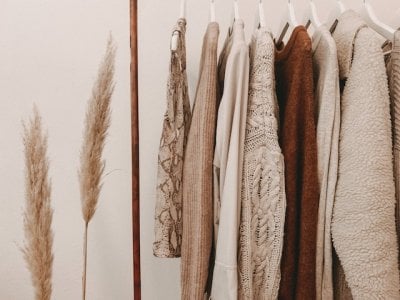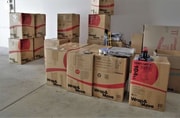Is the rising cost-of-living crisis unfairly impacting local op shops?
By
Seia Ibanez
- Replies 6
Australia's second-hand fashion industry is feeling the squeeze as costs continue to climb.
Op shops have long played a vital role in sustainable fashion and the circular economy. Not only do they divert tonnes of textiles from landfill each year, they also provide affordable style options for all budgets.
However, with inflation rising and disposable incomes decreasing, are these ‘eco-friendly’ stores in danger of going out of business?
Monica Schnieper has had her consignment store, Pelle Shoes, in Paddington for the past 27 years and believes in the power of recycling.
'I got it from my grandmother and mum,’ she said.
‘The idea of second-hand has gone from dowdy charity shops to a place where you can buy one-off, beautiful things,' she added.
'There used to be almost a stigma attached to it. People have started seeing the beauty of sustainability. There’s a trend, 100 per cent.'

To Schnieper, second-hand selling is more than a job.
‘It’s a direction. I’m very happy I’m part of it,’ she said.
‘It’s important to get the consumer and producers and the whole food chain, so to speak, involved, make them all accountable, and proud to be part of a bigger picture.’
Schnieper expects to see more government incentives for their field.
Australia is the second-highest consumer of textiles, next only to the United States. Around 7000 tonnes of textiles are recycled Down Under yearly.
A recent YouGov Omnibus research revealed the extent of the situation. Seventy-five per cent of Australian adults have thrown their clothes in the previous year, while 30 per cent have thrown more than ten items in the past year.
According to the Australian Fashion Council’s (AFC’s) report, Australians purchase, on average, 15kg or 56 new clothes per person per year. AFC called for a levy on clothing imports to reduce textile waste. However, a $1 million grant was given to the AFC to help address fast fashion waste.
The National Clothing Product Stewardship Scheme, Seamless, aims to reduce national textile waste by 2030.
'I don’t think there is enough support or even awareness for clothing waste,' says Yana Malyutina, who runs the Instagram account What We Wore with consignment clothes, shoes and accessories from her home in Lane Cove for three years.
‘I definitely think there should be better education and awareness in this field,’ she added.
Malyutina is also looking forward to more government support and educating the public on how big the fashion waste is in Australia.
Meanwhile, Clean Up Australia chair Pip Kiernan claimed that the government is part of the issue.
‘This absolutely needs support. There’s a lot of room for improvement,’ Kiernan said.
June Environment Minister Sussan Ley said that clothing textile waste was included in the National Priority Waste, along with electronics, plastic oil containers, and child car seats.
Aleasha McCallion, one of the authors of the report Textiles: A Transitions Report for Australia for Monash University, said they found in their research that the government should follow France’s lead and ban textiles from going to landfills.
The research recommended establishing a round-table event to unite stakeholders across the fashion and textile industry to co-design an Australian sector that is responsible and sustainable.
It also suggested identifying a comprehensive vision for the Australian fashion and textile industry, setting specific time-bound and evidence-informed transition targets.
‘We know that we need to reduce the consumption,’ McCallion said.
‘We’re always looking to co-design with the government and making sure that the government reacts to the importance of this. We always forget textiles.’
Venla owners Satu Raunola-Spencer and Minna Monaghan opened a ‘rent-a-rack’ shop in Mosman, Bondi Junction, and Balmain in 2021.
‘It just went off. People are very keen to recycle and help the environment,’ Raunola-Spencer said.
She added, ‘It would be great if there was a scheme of sorts for being green. A real shift has happened.’
Monaghan said, ‘You don’t always have to buy new.’
She wanted to see a marketing campaign to encourage people to think twice before buying something, saying there needs to be a shift in attitude.
They suggested tax cuts for environmentally friendly businesses and have more advertising for them.
Finnish expats also said that the government should try a ‘green scheme,’ where people get rewarded for practising sustainability and being environmentally friendly.
Miss Earth Australia Sheridan Mortlock—an ambassador for the Taronga Rubbish Run—has been ‘deeply passionate’ about global sustainability.
Mortlock said, ‘Fashion is a really easy way to make a change.
‘Op shops are a fantastic way of buying second-hand. You can find some beautiful pieces and think outside the trends,’ she added.
She suggested hiring clothes and hosting wrap parties to be more environmentally friendly. She urged the government to support op shops so they can pay more staff.
The NSW Department of Customer Services notes that it is indeed providing small businesses across the country with ‘free, ongoing and personalised support.’
‘This includes helping customers to start and grow a business, access government programs and support such as grants, rebates and vouchers, as well as provide information on the licences businesses need to stay compliant,” a spokesperson for the department said.
‘Small business owners can also connect with independent advisers with relevant industry experience, such as retail trade, to get tailored advice specific to their business,’ they added.
Despite the op shops’ call for help from the government, they are also receiving complaints from their customers. In a previous story, a woman slammed op shops on social media about how second-hand clothing is increasing in price. Read more about it here.

What do you think of this story? Let us know in the comments below!
Op shops have long played a vital role in sustainable fashion and the circular economy. Not only do they divert tonnes of textiles from landfill each year, they also provide affordable style options for all budgets.
However, with inflation rising and disposable incomes decreasing, are these ‘eco-friendly’ stores in danger of going out of business?
Monica Schnieper has had her consignment store, Pelle Shoes, in Paddington for the past 27 years and believes in the power of recycling.
'I got it from my grandmother and mum,’ she said.
‘The idea of second-hand has gone from dowdy charity shops to a place where you can buy one-off, beautiful things,' she added.
'There used to be almost a stigma attached to it. People have started seeing the beauty of sustainability. There’s a trend, 100 per cent.'

Op shops are struggling to keep their business alive and are asking for financial support. Credit: Unsplash
To Schnieper, second-hand selling is more than a job.
‘It’s a direction. I’m very happy I’m part of it,’ she said.
‘It’s important to get the consumer and producers and the whole food chain, so to speak, involved, make them all accountable, and proud to be part of a bigger picture.’
Schnieper expects to see more government incentives for their field.
Australia is the second-highest consumer of textiles, next only to the United States. Around 7000 tonnes of textiles are recycled Down Under yearly.
A recent YouGov Omnibus research revealed the extent of the situation. Seventy-five per cent of Australian adults have thrown their clothes in the previous year, while 30 per cent have thrown more than ten items in the past year.
According to the Australian Fashion Council’s (AFC’s) report, Australians purchase, on average, 15kg or 56 new clothes per person per year. AFC called for a levy on clothing imports to reduce textile waste. However, a $1 million grant was given to the AFC to help address fast fashion waste.
The National Clothing Product Stewardship Scheme, Seamless, aims to reduce national textile waste by 2030.
'I don’t think there is enough support or even awareness for clothing waste,' says Yana Malyutina, who runs the Instagram account What We Wore with consignment clothes, shoes and accessories from her home in Lane Cove for three years.
‘I definitely think there should be better education and awareness in this field,’ she added.
Malyutina is also looking forward to more government support and educating the public on how big the fashion waste is in Australia.
Meanwhile, Clean Up Australia chair Pip Kiernan claimed that the government is part of the issue.
‘This absolutely needs support. There’s a lot of room for improvement,’ Kiernan said.
June Environment Minister Sussan Ley said that clothing textile waste was included in the National Priority Waste, along with electronics, plastic oil containers, and child car seats.
Aleasha McCallion, one of the authors of the report Textiles: A Transitions Report for Australia for Monash University, said they found in their research that the government should follow France’s lead and ban textiles from going to landfills.
The research recommended establishing a round-table event to unite stakeholders across the fashion and textile industry to co-design an Australian sector that is responsible and sustainable.
It also suggested identifying a comprehensive vision for the Australian fashion and textile industry, setting specific time-bound and evidence-informed transition targets.
‘We know that we need to reduce the consumption,’ McCallion said.
‘We’re always looking to co-design with the government and making sure that the government reacts to the importance of this. We always forget textiles.’
Venla owners Satu Raunola-Spencer and Minna Monaghan opened a ‘rent-a-rack’ shop in Mosman, Bondi Junction, and Balmain in 2021.
‘It just went off. People are very keen to recycle and help the environment,’ Raunola-Spencer said.
She added, ‘It would be great if there was a scheme of sorts for being green. A real shift has happened.’
Monaghan said, ‘You don’t always have to buy new.’
She wanted to see a marketing campaign to encourage people to think twice before buying something, saying there needs to be a shift in attitude.
They suggested tax cuts for environmentally friendly businesses and have more advertising for them.
Finnish expats also said that the government should try a ‘green scheme,’ where people get rewarded for practising sustainability and being environmentally friendly.
Miss Earth Australia Sheridan Mortlock—an ambassador for the Taronga Rubbish Run—has been ‘deeply passionate’ about global sustainability.
Mortlock said, ‘Fashion is a really easy way to make a change.
‘Op shops are a fantastic way of buying second-hand. You can find some beautiful pieces and think outside the trends,’ she added.
She suggested hiring clothes and hosting wrap parties to be more environmentally friendly. She urged the government to support op shops so they can pay more staff.
The NSW Department of Customer Services notes that it is indeed providing small businesses across the country with ‘free, ongoing and personalised support.’
‘This includes helping customers to start and grow a business, access government programs and support such as grants, rebates and vouchers, as well as provide information on the licences businesses need to stay compliant,” a spokesperson for the department said.
‘Small business owners can also connect with independent advisers with relevant industry experience, such as retail trade, to get tailored advice specific to their business,’ they added.
Despite the op shops’ call for help from the government, they are also receiving complaints from their customers. In a previous story, a woman slammed op shops on social media about how second-hand clothing is increasing in price. Read more about it here.
Key Takeaways
- Australia’s cost-of-living crisis is threatening the future of local sustainable fashion, with sellers and designers calling for government help to survive.
- Rising interest rates, inflation and economic challenges have put sellers of second-hand clothes in a difficult position, claiming they need more financial support due to their environmentally-friendly practices.
- Data from the Australia Fashion Council reveals Australians, on average, buy 15kg, or 56 new items, of clothes every year, most of which ends up in landfill, contributing to immense textile waste.
- There have been calls for more government support, education for the public about fashion waste and incentives for businesses that practice sustainable fashion.
What do you think of this story? Let us know in the comments below!







